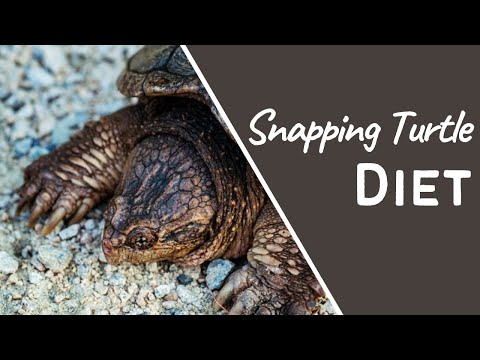Snapping turtles are fascinating creatures known for their powerful jaws and unique appearance. One aspect that often piques interest is their diet – a true testament to their predatory nature.

In this comprehensive guide, we’ll delve into the world of the snapping turtle’s culinary preferences, exploring what they eat, how they hunt, and the role their diet plays in maintaining ecological balance.
What Do Snapping Turtles Eat?
As carnivorous reptiles, snapping turtles have a voracious appetite for a wide variety of protein-rich foods. Their diet primarily consists of:
Fish and Aquatic Creatures
Snapping turtles are expert hunters in the water, preying on fish, frogs, crayfish, and other aquatic creatures that come within their reach.
Their powerful jaws and sharp beaks make them formidable predators, capable of tearing through the toughest of prey.
Small Mammals and Birds
While they primarily hunt in the water, snapping turtles will not hesitate to venture onto land in search of a tasty meal.
Small mammals like mice, voles, and even baby ducks or goslings are fair game for these opportunistic eaters.
Carrion and Decaying Matter
Snapping turtles are not picky eaters and will happily scavenge on carrion or decaying matter they come across.
This behavior helps them conserve energy and ensures they don’t miss out on any potential source of nutrition.
Plants and Vegetation
Though primarily carnivorous, snapping turtles may occasionally supplement their diet with aquatic plants and vegetation. This provides them with additional nutrients and fiber, contributing to their overall well-being.
How does the snapping turtle diet contribute to maintaining a balanced ecosystem?
The snapping turtle’s diverse diet contributes to maintaining a balanced ecosystem in several key ways:
- Population control: As apex predators, snapping turtles help regulate the populations of fish, frogs, crayfish, and other aquatic creatures they prey upon. By keeping these prey species in check, they prevent overpopulation and ensure a healthy balance within the marine food web.
- Nutrient cycling: Snapping turtles are opportunistic scavengers, feeding on carrion and decaying matter. This scavenging behavior aids in the decomposition process, breaking down organic matter and recycling nutrients back into the environment. These recycled nutrients support the growth of plants and other organisms, facilitating a crucial nutrient cycle essential for ecosystem balance.
- Ecosystem engineering: Through their nesting and burrowing activities, snapping turtles create microhabitats that provide shelter and breeding grounds for various species, such as insects, amphibians, and small mammals. This ecosystem engineering increases biodiversity and complexity within the environment, contributing to its overall balance and resilience.
By fulfilling their roles as predators, scavengers, and ecosystem engineers through their varied dietary habits, snapping turtles play a vital part in maintaining the delicate equilibrium of aquatic and terrestrial ecosystems.
Their feeding behaviors help regulate population sizes, facilitate nutrient cycling, and create habitats, ultimately fostering a balanced and thriving ecological community.
Hunting Tactics and Feeding Habits
Snapping turtles are patient hunters, employing various tactics to secure their next meal:
Ambush Predators
These reptiles are masters of ambush, lying in wait for unsuspecting prey to come within striking distance. Their camouflage and ability to remain motionless for extended periods make them highly effective ambush predators.
Scavenging Behavior
As opportunistic feeders, snapping turtles will readily scavenge on any available carcasses or decaying matter they come across. This behavior ensures they don’t miss out on potential sources of nutrition, contributing to their survival.
Powerful Jaws and Bite Force
One of the most remarkable features of snapping turtles is their powerful jaws and immense bite force. With a bite that can sever a finger or toe, these turtles can easily overpower and consume even the toughest of prey.
The Role of Snapping Turtles in Ecological Balance
The snapping turtle’s diet plays a crucial role in maintaining the delicate balance of aquatic ecosystems:

Population Control
By preying on fish, frogs, and other aquatic creatures, snapping turtles help regulate the populations of these species, preventing overpopulation and ensuring a healthy ecosystem.
Nutrient Cycling
As scavengers, snapping turtles contribute to the decomposition process, helping to recycle nutrients back into the environment supporting the growth of plants and other organisms.
Ecosystem Engineering
The nesting and burrowing behaviors of snapping turtles create habitats for other species, further contributing to the diversity and richness of the ecosystem.
Conservation Efforts and Threats
Despite their important ecological role, snapping turtles face various threats, including habitat loss, pollution, and human interference. Conservation efforts are crucial to ensure the survival of these remarkable creatures:
Habitat Protection
Preserving and restoring wetlands, rivers, and other aquatic habitats is essential for the long-term survival of snapping turtles and the species they prey upon.
Reducing Pollution
Minimizing the release of pollutants, such as chemicals and plastics, into waterways can help protect snapping turtles and the ecosystems they call home.
Responsible Interaction
Educating the public about the importance of snapping turtles and promoting responsible interaction can help reduce human-caused threats and ensure these reptiles are treated with respect.
Conclusion
The snapping turtle’s diet is a fascinating and essential aspect of their existence, reflecting their role as apex predators in aquatic ecosystems.
From their diverse culinary preferences to their hunting tactics and ecological significance, these reptiles are truly remarkable creatures.
By understanding and appreciating their dietary habits, we can better appreciate the intricate web of life that exists in nature and the importance of preserving these magnificent creatures for generations to come.

